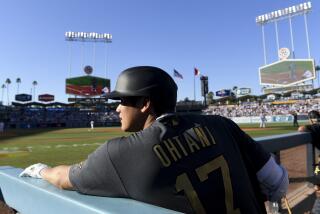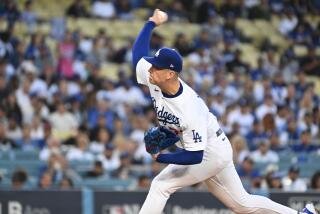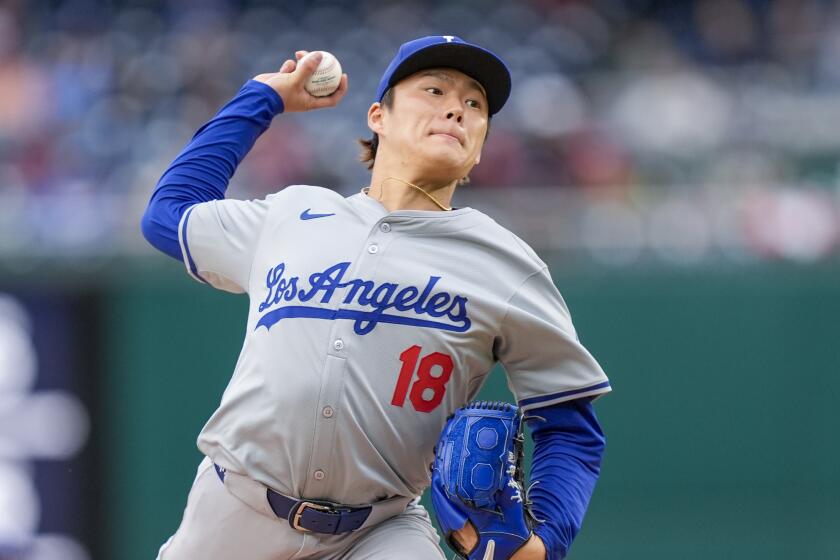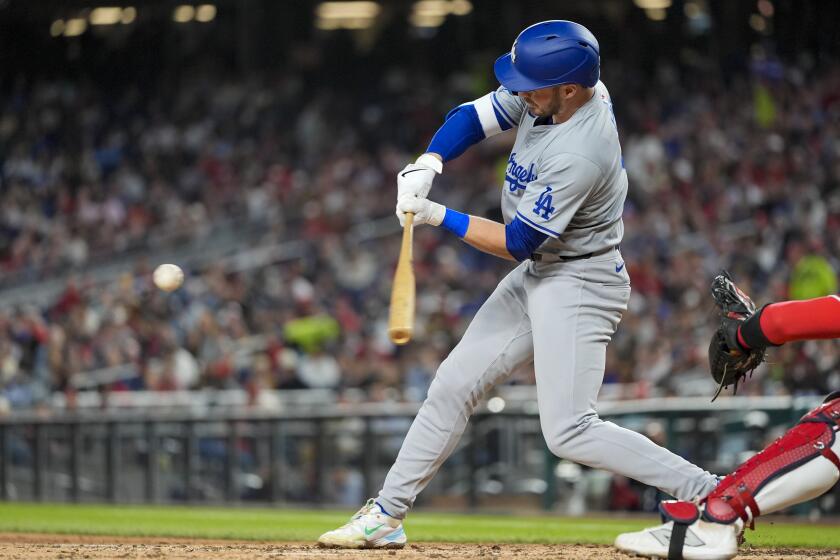Analysis: Brad Peacock’s outing is old-school baseball

Former Santa Monica High and UCLA standout Tim Leary pitched 13 years in the big leagues and had his best season for the 1988 World Series-champion Dodgers, going 17-11 with a 2.91 ERA in 35 games.
The right-hander threw three scoreless innings in Game 1 of the 1988 series against Oakland and 32/3 one-run innings in Game 3. Now 58, Leary is serving as a guest analyst for the World Series with an assist from Times staff writer Mike DiGiovanna.
DiGiovanna: There were two divergent bullpen strategies, with the Dodgers using four relievers to match up in the final 22/3 innings and the Astros using one — Brad Peacock — to throw the final 32/3 innings. Any preference?
Leary: There aren’t many 11-out saves anymore. That was kind of old-school baseball right there. The guy is hot, you leave him in. It’s not a typical game in any way, shape or form, but this is baseball in 2017, and a lot of things have changed.
Any time your starter is knocked out in the second inning, you’re in a world of hurt. I thought the Dodgers were fortunate to hold the Astros where they did. It’s tough to manage from behind, and I thought Dave Roberts did a great job.
With the Dodgers, that’s the way they’re built. Ever since [Lance] McCullers got the four-inning save in the American League Championship Series, it was clear to me that the Astros were gonna use a starter or two out of the bullpen, guys who could carry high pitch counts and save their other relievers.
The Dodgers had the tying run at the plate after Andre Ethier walked with two outs in the seventh, and Chris Taylor, who has been one of their hottest hitters, grounded out to first. Was that Peacock’s biggest out?
Definitely. Peacock threw fastballs most of the night, but that was the one batter he started off with two sliders to get ahead, one down and away that Taylor swung through and one down the middle that Taylor took for a strike. After a ball, Taylor chopped a 94-mph fastball into the ground.
I give [catcher Brian] McCann a lot of credit. Peacock went with what his catcher was calling. He had great command of his fastball. It was on the corners, up, and he even fooled guys in the middle. He’s a tough guy to hit with his arm angle and movement.
Cody Bellinger struck out four times and is 0 for 11 with seven strikeouts in the series. What are you seeing in his at-bats? Should the Dodgers bench him or drop him in the order?
His swing is a little long right now. He could be pulling off the ball a little. That breaking ball down and in is really handcuffing him. And that last at-bat, he got a lot of fastballs when he was probably looking for breaking balls. It’s a mind game.
He’s getting some pitches to hit, but you can’t put that much on a 21-year-old to be a game saver. It’s only Game 3, and he could turn it around. I still think you have to keep him in the middle of the order because he’s a game-changer, an impact player.
Dodgers right-hander Yu Darvish said before his Game 3 start that he wouldn’t be “thinking too much about pressure.” Did he ever look comfortable to you?
No, he looked nervous to me. He threw a lot of strikes, but it seemed like his pitches weren’t as lively as they normally are. He was missing far more than he has in his recent starts. It’s a different stage, the World Series, and the pressure can get anybody.
George Springer really set the tone for the Astros in his first at-bat. Darvish fell behind with four fastballs, and Springer crushed a 3-1 fastball to the gap in right-center. That motivates a team when your leadoff guy hits a ball that hard. You think that pitcher is hittable.
Darvish threw a fastball in the first that was clocked at 98 mph. He has a wide array of breaking balls. By the time he left in the second, he had induced only two swings and misses among his 49 pitches. How is that possible?
It just goes to show you how good major league hitters are, and that the Astros’ bats have come alive. Any hittable pitch from Darvish, they seemed to be on it, and they fouled off a lot of close pitches. It’s tough being a pitcher in the major leagues. Your best chance, no matter the era you played in, is to throw the ball down, like Orel Hershiser always did.
Kenta Maeda relieved Darvish and gave up one hit in 22/3 innings and has given up two hits in nine postseason innings, with nine strikeouts and one walk. Why has he been so dominant in relief?
Maeda’s slider is perfect for the bullpen right now. At his age, and at this point in his career, he’s pretty much a fastball-slider pitcher who doesn’t throw 96 mph but has great command of both pitches. He can go one time through the lineup and probably be great. They may have to look at him as that type of pitcher.
I noticed in one of his relief outings, he was overthrowing. He was definitely throwing harder, but I think he realized he was trying to throw too hard, when he really should be doing what he just did in Game 2 and in Game 3, which is throw a lot of sliders, especially to the top three guys in the order.
The only problem was that Maeda threw 42 pitches, likely taking him out of the mix for Game 4.
What was Yasiel Puig thinking in the fourth when, with the Dodgers down by three, he ran through the first base bag on a hit to left, made a dash for second and was thrown out?
That was a mistake. Down by three, you can’t do that. It’s an absolute no-no. But he’s an aggressive player, and in a sense, he beat the throw to second. But he rolled off the base, and [Houston second baseman] Jose Altuve made a great diving tag. Puig can’t chance it, bottom line.
The Los Angeles Dodgers in the 2017 World Series
Follow Mike DiGiovanna on Twitter @MikeDiGiovanna
More to Read
Are you a true-blue fan?
Get our Dodgers Dugout newsletter for insights, news and much more.
You may occasionally receive promotional content from the Los Angeles Times.







